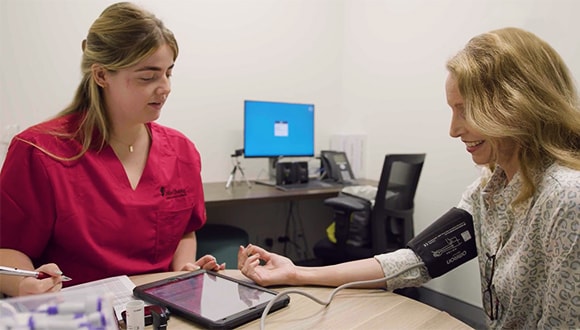Reduce your salt habit for a healthy heart
Published March 2025 | 7 min read
Expert contributor Professor Jason Kovacic, cardiologist and Director, Victor Chang Cardiac Research Institute
Words by Jo Hartley
Cutting back on salt is a simple way to keep your heart happy. Luckily, these small changes to your diet can have a big impact – without sacrificing flavour.
We’ve been adding salt to our food for centuries, but the health impacts of using too much, too often can be concerning. It’s a food habit we need to shake.
“Salt is a vital component of our bodies and bloodstream and plays a key role in many of our blood's functions," says Professor Jason Kovacic, cardiologist and Director of the Victor Chang Cardiac Research Institute.
“We all need salt, but problems arise when we consume too much of it. Salt retains water in our bloodstream, which can elevate blood pressure and increase the risk of strokes, heart attacks and heart disease.”
It’s estimated that more than 2,500 Australians die each year from illnesses caused by high salt intake. The benefits of reducing salt are clear. According to the Grattan Institute, cutting salt consumption could save hundreds of lives, as well as millions of dollars in healthcare expenditure.
So where is salt hiding in our diet and how can we reduce it to improve heart health?
What is salt?
Salt is a mineral composed of sodium chloride, with sodium making up about 40%. It's the sodium that can harm your health.
“Salt comes in lots of different foods and forms in our daily diets,” says Prof Kovacic, explaining the most common source is salt added during cooking of the foods we buy or make at home.
“Because salt has been added to foods for centuries, it's a flavour that we like,” he says. “We’ve developed specific taste receptors for it, so we add it to lots of things, which means our intake is high.”
While you can be across how much table salt you're sprinkling on your meals, the salt in cooked and processed foods is a different story.

Where does the salt in our diet come from?
About 75% of the salt we consume comes from processed foods, much of it hidden during cooking and preparation.
“When preparing food yourself with fresh ingredients, you’re aware of the amount of salt added,” says Prof Kovacic. “The tricky part is when you’re eating out or ordering takeaway and there’s no packaging information. It’s hard to know the quantity of salt in the food, so people often underestimate it.”
Foods with the highest levels of sodium include:
- potato chips and salty snack foods
- processed meat
- meat products like sausages, meat pies, sausage rolls and chicken nuggets
- cheese
- pizza
- white bread
- certain sauces, spreads and condiments
- packaged and processed ‘ready meals’.
How much salt should I have?
Australian guidelines recommend adults should have about 2,000mg of sodium – about 5g or 1 teaspoon of salt – per day. But the average Australian consumes almost double (1.9 times) the recommended daily salt level and a lot of that comes down to labelling, says Prof Kovacic.
“Salt and sodium are often used interchangeably on food packaging,” he notes. “For example, if you buy a can of vegetable soup, the amount of salt is reported as sodium.”
Food labels in Australia must list any salt and sodium-containing additives in the ingredients, and the total sodium content of packaged foods must also be listed on the label’s nutrition information panel.
Check the nutrition list on the label for the amount of sodium per 100g – use this as a comparison with similar foods. Prof Kovacic recommends in general opting for foods that contain 400mg or less of sodium per 100g, but the best choices are low-salt options, which generally have under 120mg of sodium per 100g.
Am I eating too much salt?
High blood pressure is one of the most common signs you might be eating too much salt, says Prof Kovacic.
“This often goes hand in hand with people being overweight, not exercising and just generally not paying enough attention to their health overall.”
A GP or health professional can measure your blood pressure and offer advice on lifestyle changes if needed. For more in-depth guidance on food choices, a dietitian can help.
Eligible HCF members* can access a free heart health check at selected locations and dates, thanks to our partnership with the Victor Chang Cardiac Research Institute. By getting a Heart Health Check, you can get an insight into your blood pressure, total cholesterol and average blood sugar levels.

How can I reduce salt in my food?
The first step, says Prof Kovacic, is to aim to eat a healthy, well-balanced diet with a variety of fruit and vegetables – cooking reduced-salt recipes. Remove salt from the dinner table and avoid adding it when cooking. Instead, you can substitute salt with other spices for flavour when cooking. “Try adding garlic or a bit more pepper,” says Prof Kovacic.
Avoid or cut back on packaged or processed foods like pizzas, burgers and potato chips, and switch to low-sodium or potassium-enriched salt. It's usually sold as light salt or heart-healthy salt at most larger supermarkets.
“Studies show that if you only use the potassium-enriched salt substitutes, your blood pressure will lower, which will reduce your risk of stroke and cardiovascular events,” says Prof Kovacic.
Lastly, he adds, when you can, choose food items that are labelled as ‘salt reduced’ or ‘no added salts’ with less than 120mg of sodium per 100g.
Salt intake in children
Reducing salt in children’s diets is important, says Prof Kovacic.
“Increased screen time and less exercise mean children are having more trouble with weight management and overall health. Salt intake and blood pressure is a part of this.”
Children generally require less salt than adults and their recommended daily sodium intake depends on their age.
- One to three years (200 to 400mg/day)
- Four to eight years (300 to 600mg/day)
- Nine to 13 years (400 to 800mg/day)
- 14 to 18 years (460 to 920mg/day)
Prof Kovacic suggests taking the following steps to reduce salt in children's diets.
- Choose products and foods that are low in salt – check nutritional information.
- Cook with fresh produce as much as you can and add in plenty of vegetables.
- Replace salty snacks with healthier options like fruit.
- Order less takeaway food.
- Remove salt from the dinner table.
- Avoid letting children add their own salt to food.
Making healthier choices
We’re helping eligible members save^ on the evidence-based CSIRO Total Wellbeing Diet. Created by Australia’s national science agency, the program combines a higher protein, low-GI eating plan with proven weight loss tools to help improve habits and create lifelong positive behaviours.
Related articles
What’s the right diet to help with high blood pressure?
A balanced diet is a vital part of lowering high blood pressure and reducing the risk of heart disease. Here's what you need to know about the DASH diet.
How to read food labels and nutritional information
Make better food choices by understanding how to read food labels and what they mean for your nutrition. You might be surprised at what you find.
How to prevent heart disease and live longer
1 in 4 Aussies will die from heart disease. We speak to the experts to find out how you can prevent heart disease with some easy, healthy habits.
9 heart-healthy foods for a healthy diet
Maintaining a heart-healthy diet is one of the best ways to reduce your risk of developing heart disease. Try incorporating these heart-healthy foods.
IMPORTANT INFORMATION
* Must have hospital cover with HCF (excluding Overseas Visitors Health Cover). For more information see hcf.com.au/victorchang
^ Eligibility criteria apply. For more information see hcf.com.au/csiro-total-wellbeing-diet
This communication contains information which is copyright to The Hospitals Contribution Fund of Australia Limited (HCF). It should not be copied, disclosed or distributed without the authority of HCF. Except as required by law, HCF does not represent, warrant and/or guarantee that this communication is free from errors, virus, interception or interference. All reasonable efforts have been taken to ensure the accuracy of material contained on this website. It’s not intended that this website be comprehensive or render advice. HCF members should rely on authoritative advice they seek from qualified practitioners in the health and medical fields as the information provided on this website is general information only and may not be suitable to individual circumstances or health needs. Please check with your health professional before making any dietary, medical or other health decisions as a result of reading this website.